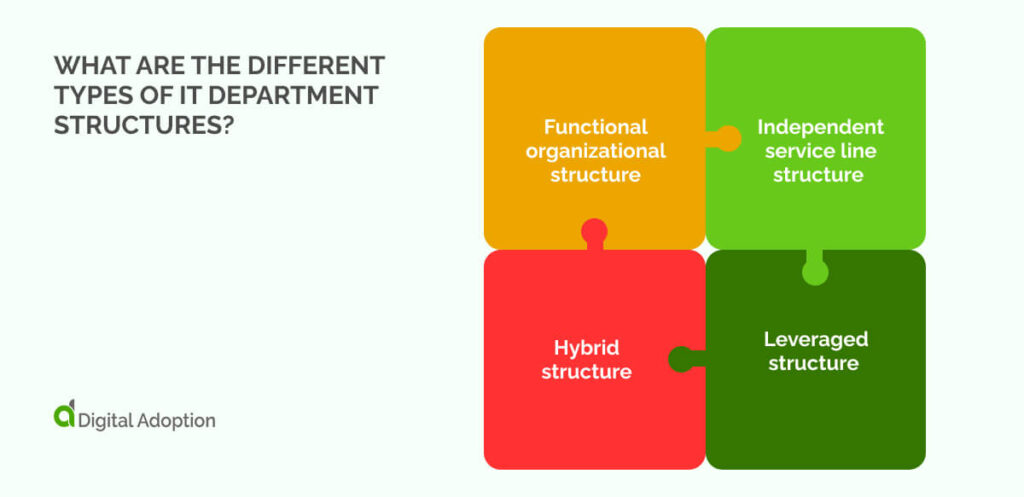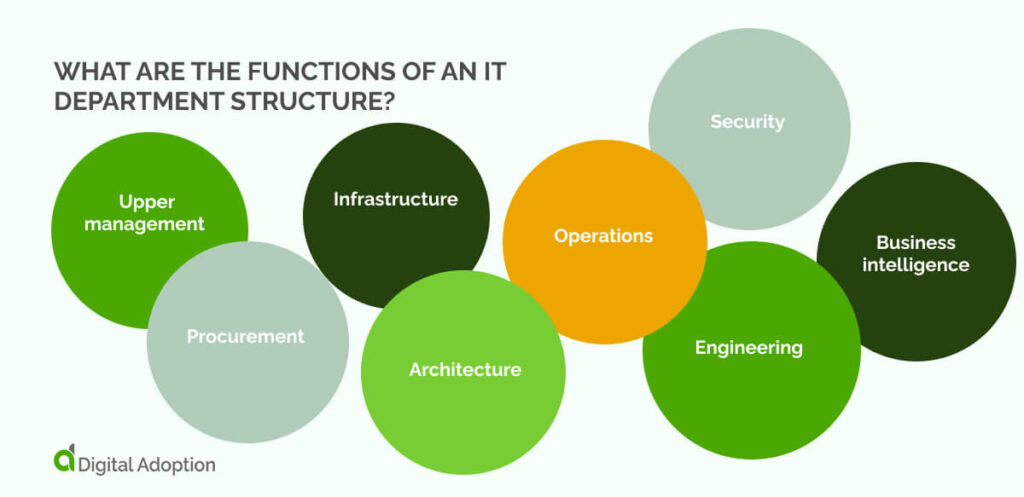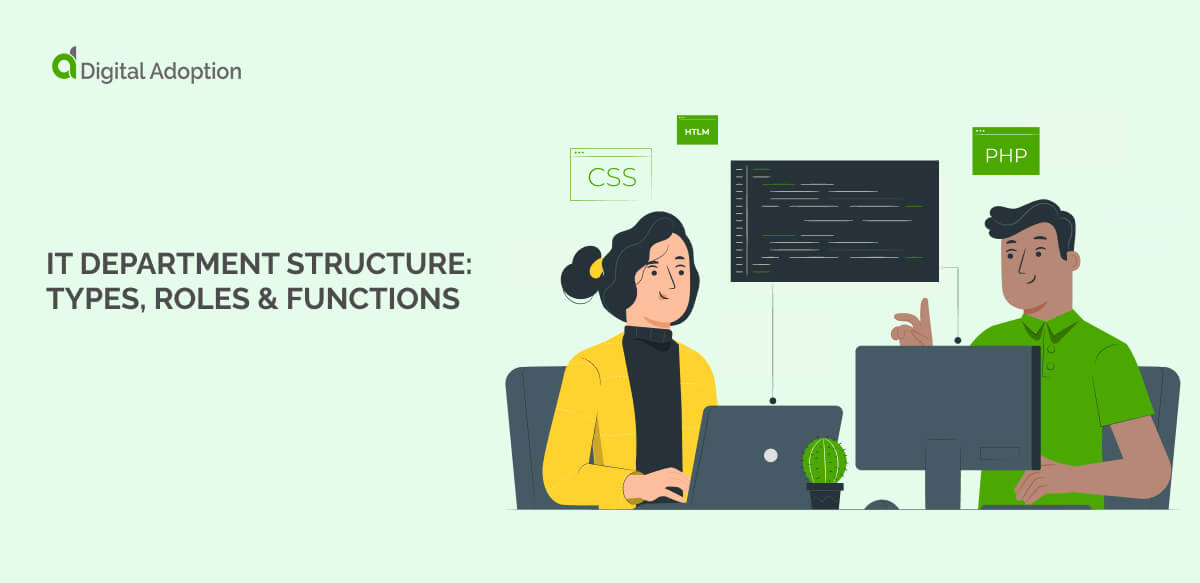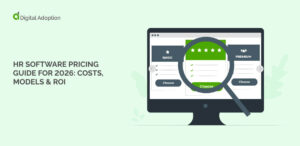In the last decade, the IT department has transformed from a non-priority unit into one of the most important strategic assets in an organization.
Statista says global IT spending reached $4.9 trillion in 2023 and is projected to hit $5.3 trillion in 2024. The sheer amount of money poured into IT spending highlights how influential the IT department is becoming.
In addition to traditional functions like cybersecurity, IT departments are now at the forefront of digital innovation. They drive business strategy and competitive advantage through emerging technologies and data-driven insights.
However, digital transformation becomes harder if your IT department structure isn’t organized properly. The result is a fragmented approach that slows project delivery and fails to align IT objectives.
This article will explore the modern IT department structure, including the different types, roles, and functions. It will also show you how to build your own IT department structure tailored to your organization’s size.
- What is an IT department structure?
- What are the different types of IT department structures?
- What are the different roles in an IT department structure?
- What are the functions of an IT department structure?
- How to build an IT department structure
- Optimizing your IT department structure for success
- People Also Ask
What is an IT department structure?
An IT department structure is the framework that defines how an IT team is arranged and operates within a company.
It outlines roles, responsibilities, reporting lines, and communication channels for IT professionals. This structure typically includes various units. Infrastructure management, software development, cybersecurity, and data analytics are common examples.
IT department structures specify how resources are allocated, and decisions are made. They also determine how the department aligns with overall business goals.
IT departments should deliver reliable services and promote innovation. They also support digital transformation and use technology to drive business value.
What are the different types of IT department structures?

There are many different types of IT department structures. The goal is to find one that suits your business’s needs.
This isn’t as easy as it sounds. You have to be aware of the organization’s size, industry, goals, and technology requirements.
This section will explain the different types of IT department structures.
Let’s take a look at the IT department structures most modern businesses use:
Functional organizational structure
Functional IT teams group staff by their skills and duties. More experienced workers guide newer ones. IT managers lead technicians, who then oversee other IT staff. Large companies may have special teams, like help desk or security experts. This setup is step-by-step, with clear reporting lines.
Advantages
- Clear reporting lines
- Efficient skill-based grouping
- Promotes specialization within teams
Disadvantages
- Risk of team isolation
- Might slow cross-functional communication
- Can limit wider tech skill growth
Independent service line structure
Each IT team runs its own services in an independent service line setup. This covers software, hardware, and staff. Teams share power and focus on customer needs. Each unit works on a specific technical area. This structure gives teams more freedom to make choices and work independently.
Advantages
- Clear focus on specific services
- Easier to measure performance
- Allows for specialized expertise
Disadvantages
- Risk of team isolation
- Might slow team-to-team talk
- Can limit wider tech skill growth
Leveraged structure
A leveraged IT structure uses outside help for many tasks, from office work to software care. It’s good for small IT teams with limited resources. The IT department works with vendors to handle tasks and get expert help. This lets the in-house team focus on main goals and big projects.
Advantages
- Cuts running costs
- Gives access to expert knowledge
- Let’s the in-house team focus on core skills
Disadvantages
- Might lose control of some IT functions
- Relies on outside companies
- May lead to communication challenges
Hybrid structure
A hybrid IT structure uses both cloud and in-house tools. It balances cost and control, keeping key assets close while using cloud benefits. This new setup needs good planning and clear communication to work well. Big companies should watch for conflicts between departments. It’s a mix of old and new ways.
Advantages
- Blends cloud and on-site systems
- Provides more flexibility and room to grow
- Enables smarter use of resources
Disadvantages
- Can be tricky to handle and combine
- Needs thorough planning and oversight
- Might cause data safety and compliance issues
What are the different roles in an IT department structure?
Now that you understand the different types of IT department structure, let’s move on to the roles you might find within the department.
Chief Information Officer (CIO)
A chief information officer (CIO) leads a company’s technology and business strategy. They manage IT operations and spearhead digital initiatives. CIOs collaborate with other tech leaders, such as IT directors. Their main goal is to use technology to boost innovation and gain a competitive edge.
IT director
An IT Director guides a company’s tech strategy. They oversee IT operations, finances, and teams. Their jobs range from identifying business needs to enhancing IT abilities. IT Directors make key choices about tech investments and rules and ensure technology aligns with company goals.
IT manager
An IT Manager leads daily tech tasks, guiding teams, and planning projects. They keep systems running, manage budgets, and give tech support. This job needs broad tech knowledge to handle many IT areas. IT Managers are key in maintaining company tech and ensuring everything works smoothly.
Network manager
A network manager runs a company’s computer networks. They set up and fix network systems and control servers. This role is growing as IT becomes more complex. Their main task is to keep data flowing smoothly between teams. They ensure network stability and handle any connection issues that arise.
Development manager
A development manager leads the software team. They keep apps running and check code quality. They plan projects and set coding rules for the company. Their role includes overseeing app maintenance and ensuring code meets standards. They guide the team in creating and improving software products.
Information security manager
An information security manager protects digital assets, enforces security rules, and tracks incident responses. This role involves teaching staff about security and keeping up with new threats. Security managers ensure the company follows security laws and best practices. Their main job is to prevent and respond to cyber-attacks.
Business intelligence (BI) manager
A business intelligence (BI) manager leads data analysis work. This role involves handling how data is collected, stored, and understood. BI managers oversee tools and data storage systems. Their job includes creating reports to help make decisions. Working with different teams, they meet data needs and improve business insights.
What are the functions of an IT department structure?

Understanding the functions or “responsibilities” of an IT department structure is key to building an efficient team.
However, companies may need different IT structures based on size, industry, and goals. It’s important to recognize that one size doesn’t fit all when it comes to IT departments.
Let’s take a closer look at the various functions of an IT department structure:
Upper management
Upper managers guide the IT department’s overall direction. Like CIOs or CTOs, they focus on strategy and plan for problems. These leaders oversee other department heads. Their role ensures IT goals match business aims. Upper managers balance long-term planning with daily operations to keep tech running smoothly.
Procurement
The procurement team buys and manages IT resources. They handle vendor relationships, negotiate contracts, and ensure cost-effective purchases. Procurement works closely with other departments to understand their technology requirements. They also track inventory and plan for future IT investments and procurement-led digital transformations.
Infrastructure
Infrastructure engineers maintain IT systems and oversee servers, networks, and data centers to ensure smooth operations. Their tasks include monitoring system stability, planning upgrades, and implementing disaster recovery protocols. A robust digital infrastructure supports operational resilience and drives competitive advantage.
Architecture
Technical architects design IT structures, create system plans, and ensure components work together. Their role involves planning for future tech needs and setting the company’s development standards. This team guides tech choices and helps build a strong, flexible IT foundation.
Operations
This operations team keeps IT services running. They manage help desks and maintain systems. Their job includes handling updates and meeting service levels. They also respond to issues and manage IT assets. Operations ensure daily tech tasks run smoothly, supporting all users in the company.
Engineering
The engineering department builds software and deploys new tech. Engineers create apps, write code, and test solutions. This team updates existing programs to fit new needs. Their work turns ideas into real software. Engineering helps the business grow and stay current with tech changes.
Security
The security team protects digital assets. They set up and monitor security measures and manage firewalls and threats. They also create policies and ensure compliance with regulations. Security specialists keep company data safe from hackers and train staff on best practices.
Business intelligence
One of the newest additions to the IT department structure, business intelligence analysts manage data. They oversee data storage and analysis tools and create reports for decision-making. They work with teams to meet data needs and explain complex information.
How to build an IT department structure
Now that we’ve covered the key roles in an IT department, let’s look at how to create a structure that fits your company’s needs.
We will explore how to build an effective IT department structure tailored to different organizational sizes.
Let’s take a look at the specific approaches and considerations for small, medium, and large businesses:
Small business IT department structure
Small-sized businesses should focus on the following:
Establish core IT functions
Focusing on core IT functions might seem obvious, but many businesses fail to take these crucial steps. The main reason IT department structures fail is a lack of planning. Core IT functions are at the heart of every business. Investing the time and effort in establishing what these are and best practices for each will help small business transform their IT.
Develop flexible roles
Flexible roles are becoming more normalized and accepted, especially in small businesses. This is a crucial step in building your IT department structure. Developing and hiring the right people and skills helps smaller companies maximize their resources. It allows companies to focus on what matters while remaining cost-effective.
Outsource specialized services
In-house specialized services are expensive and can be burdensome for small businesses. Finding an external partner goes a long way in maintaining crucial services while not breaking the bank. Smaller companies usually have fewer resources, so outsourcing where you can and within reason is a good option.
Medium business IT department structure
Medium-sized businesses should focus on the following:
Expand IT leadership
Growing businesses need strong leadership. Expanding the IT team and defining specialist roles might seem expensive. However, developed teams have a higher chance of meeting organizational needs. Invest in people with the required skills to take your company to the next level. Hiring a chief technology officer (CTO) or a chief data officer (CDO) is a great way to drive innovation and strategy.
Specialize IT roles
Medium-sized businesses need specialized roles in order to grow. This means reviewing IT strategy and finding development opportunities. These can range from making the most of data to increasing cybersecurity efforts. Specialized roles help medium-sized businesses focus on key areas and adapt to changing tech needs.
Balance in-house and outsourced services
A working strategy for medium-sized businesses is mixing in-house and outside IT services. In-house teams know your business well, while outside help can save money and bring new skills. Focus on keeping priority jobs in-house and use outside help for less strategic tasks or special assignments. This plan lets you pivot quickly and is also cost-effective.
Large business IT department structure
Large businesses should focus on the following:
Establish a comprehensive IT hierarchy
When your business reaches a certain size, it’s important to establish a functional IT hierarchy. This means clearly defining roles and responsibilities from the top down. It can involve tweaking strategy to align with new roles and building a structured approach to IT. Once the new hierarchy is established, it must be maintained and evaluated.
Develop specialized departments
Specialized departments are a great way of aligning the focus of your IT department. When IT departments are fractured, communication becomes impossible, slowing down production and reducing innovation. Specialized departments focus on specific technical areas and nurturing expertise in key domains.
Align IT with business strategy
Aligning IT with business strategy is one of the most important things you can do for larger businesses. It ensures that technology investments support company goals and ultimately drive growth. This alignment ensures every tech decision drives the company forward. It helps turn IT from a cost center into a powerful business asset.
Optimizing your IT department structure for success
By now, you should know that your IT department is one of the most important business divisions.
Depending on the size and nature of your business, optimizing the IT department will help achieve better results and drive innovation across the organization.
Many businesses aim for digital transformation, but 70% fail. Paying close attention to the IT department structure is the first step toward prioritizing digital initiatives and long-term growth.
A competent IT structure creates a department that supports current needs and adapts to future technology challenges and opportunities.
People Also Ask
-
What is an IT department structure?An IT department structure is how a company sets up its tech team. It shows who does what job and how they work together. This setup helps the team run smoothly and meet the companys tech needs.
-
What is the functional structure of the IT department?A functional IT structure groups people by what they do. You might have teams for coding, networks, or support. Each team focuses on its own tasks. This helps build deep skills in each area.
-
What is the structure of the information system department?The information system department often has teams for data, software, and tech support. They work together to manage company data and keep systems running. The exact setup depends on what the company needs.
-
What is the organizational structure of IT operations?The IT operations structure often has a help desk, system admins, and network teams. These teams handle day-to-day tech tasks. A manager usually leads these teams. The structure aims to keep all tech running smoothly.









